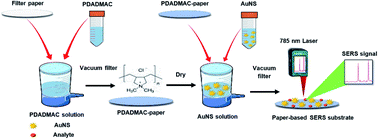Fabrication of paper-based SERS substrate using a simple vacuum filtration system for pesticides detection†
Abstract
Herein, we describe a simple and cost-effective fabrication of a paper-based SERS substrate by coating poly(diallyldimethylammonium chloride) (PDADMAC) and gold nanostars (AuNSs) on the filter paper using a vacuum filtration system. The paper-based SERS substrates were fabricated and ready to be used within an hour without any complicated equipment or processes. The cationic polymer, PDADAMAC, was pretreated on the filter paper to improve the absorbability of negatively charged AuNSs through electrostatic interaction. The PDADMAC/AuNS paper significantly intensified the SERS signal of 4-mercaptobenzoic acid (4-MBA) compared to that of pure AuNS-coated paper due to the high density of AuNSs absorbed on the SERS substrate. The PDADMAC/AuNS paper substrate provided a SERS enhancement factor (EF) of 1.08 × 107 with a low detection limit of 1 nM 4-MBA. The substrate shows excellent spot-to-spot reproducibility with a relative standard deviation (RSD) of 5.03%, and substrate-to-substrate reproducibility with an RSD of 3.20% for the Raman shift at 1080 cm−1. The paper substrate was then applied for the rapid detection of pesticides with a low detection limit of 0.51 μM (0.13 ppm) for paraquat, and 0.38 μM (0.09 ppm) for thiram, using a handheld Raman spectrometer. The development of this simple and cost-effective paper-based SERS substrate, and its applications for on-site monitoring of pesticides, could be beneficial for food security and environmental safety.

- This article is part of the themed collection: Analytical Methods HOT Articles 2022


 Please wait while we load your content...
Please wait while we load your content...